Fine motor skills, which are crucial for a child’s independence and academic success, can be nurtured using practical home activities. Bead threading, arts and crafts, and sensory play with sand enhance dexterity and hand-eye coordination. Toys with diverse textures stimulate sensory awareness and support coordination in infants and toddlers. Activities like buttoning a shirt, tying shoes, and brushing teeth help develop fine motor skills.
Writing exercises and playing musical instruments might improve the precision of school-aged children. Patience and understanding are essential in this developmental journey. Further exploring this topic would provide more precise and in-depth knowledge of developing children’s fine motor skills.
Key Takeaways
- Encourage activities like threading beads, sensory play, and arts and crafts at home to improve hand coordination and muscle strength.
- Utilize engaging activities such as sticker peeling, Cheerios stringing, and coin sorting to enhance precision and hand-eye coordination.
- Implement games like bubble blowing and Pick Up Sticks to stimulate sensory processing and enhance fine motor abilities.
- Introduce cutting, gluing, and tracing exercises to strengthen hand muscles, improve coordination, and foster creativity.
- For toddlers, stimulate sensory awareness with toys of diverse textures and promote hand-eye coordination through stacking blocks and rolling balls.
Understanding Fine Motor Skills
Delving into the domain of fine motor skills, we begin to understand the importance of the intricate coordination of small muscles in our hands and fingers. This coordination is a critical factor in activities as diverse as writing and self-grooming. Fine motor skills are an essential area of child development, fostering independence and confidence in children as they grow and learn.
These skills, though subtle, play an enormous role in a child’s academic success and day-to-day life. They facilitate essential tasks such as drawing, writing, and using utensils. Mastering these skills at an early age paves the way for academic proficiency and impacts self-care activities like dressing and grooming.
Implementing activities that promote fine motor skill development can significantly enhance a child’s independence and confidence. Providing children with ample opportunities to practice and refine these skills is vital, making them ready to take on the world with their tiny, capable hands.
Understanding fine motor skills and their importance is the first step to creating environments that foster children’s growth and development. We can support children in reaching their potential with empathy, practicality, and informed strategies.
Importance of Early Development
Why is early development of fine motor skills so vital in children? The answer lies in the very fabric of our daily lives. Fine motor skills are the building blocks that enable children to perform essential tasks like writing, dressing, and feeding. They build a child’s independence and build a strong foundation for academic success.
Consider these points:
- A child who masters fine motor skills early is better equipped for school tasks and activities. This can help eliminate potential academic struggles and foster a love for learning.
- Early intervention for nuanced motor skill challenges can prevent long-term difficulties and give the child a greater chance of success in the future.
- Healthcare providers and occupational therapists play an instrumental role in evaluating and supporting the development of fine motor skills in early childhood. Their expertise can help identify and address potential issues at the earliest stage.
The importance of early development of fine motor skills cannot be overstated. It is vital to a child’s growth and development, paving the way for a successful and independent future.
Home Activities for Skill Improvement
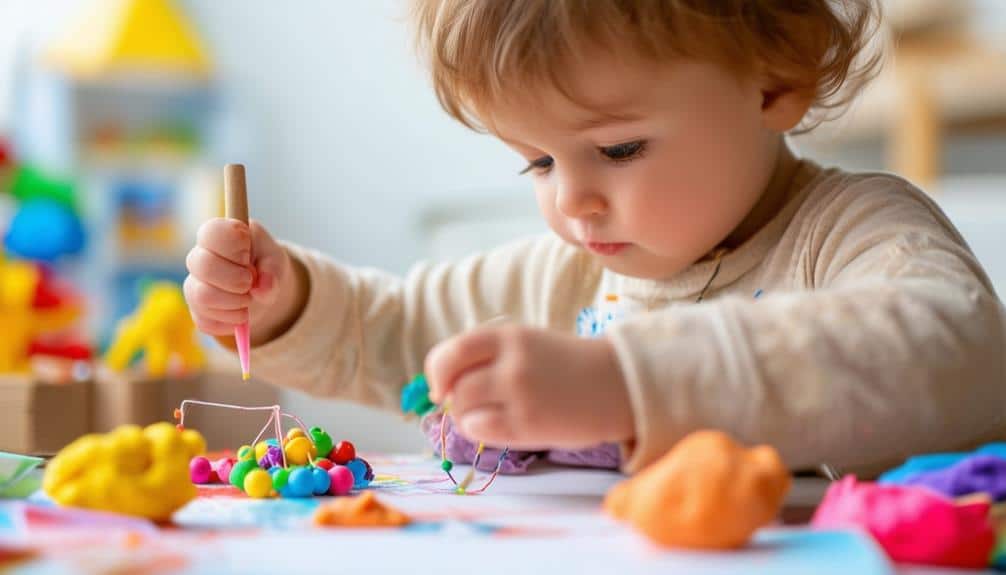
How can parents and caregivers support the development of fine motor skills in children at home? The answer lies in incorporating certain beneficial activities into their daily routine.
Engaging children in threading beads, buttoning clothes, and playing with building blocks can significantly enhance their fine motor skills. Offering arts and crafts projects that involve cutting, drawing, and coloring enhances hand coordination and muscle strength.
Activities that strengthen hand muscles, like squeezing playdough or using clothespins, can also be advantageous. Puzzles, stringing, and sticker activities, which provide opportunities for finger dexterity, are also recommended.
Sensory play with materials like rice or sand supports hand-eye coordination and fine motor skill development in early childhood.
Below is a practical guide for parents and caregivers:
| Activity | Benefit |
|---|---|
| Threading beads, buttoning clothes | Dexterity, Hand-eye coordination |
| Arts and crafts | Hand coordination, Muscle strength |
| Squeezing play dough, using clothespins | Hand muscle strength |
| Sensory play with rice, sand | Hand-eye Coordination, Fine motor skill development |
Encouraging Infant and Toddler Development
Fostering the development of fine motor skills in a child’s early years is pivotal. This can be effectively achieved by introducing carefully selected activities and toys that promote sensory development and hand-eye coordination. Supporting infant and toddler development through these methods is beneficial and enjoyable for the young.
Offer toys with diverse textures and shapes to stimulate sensory awareness. Encourage reaching, grasping, and transferring objects between hands to enhance their fine motor skills. Engaging in activities that strengthen the hand muscles, like squeezing playdough or using clothespins, is also very beneficial.
- Engage children in finger painting and sensory play using rice or sand. These activities support hand-eye coordination and the development of fine motor skills creatively and enjoyably.
- Consider games that involve stacking blocks or rolling balls. These games also help develop hand-eye coordination and fine motor skills.
- Encourage activities that promote the strengthening of hand muscles and coordination.
Remember always to approach the development of your child’s fine motor skills with patience and understanding. Every child develops at their own pace, and every effort makes a significant difference.
Kindergarten Children and Fine Motor Skills
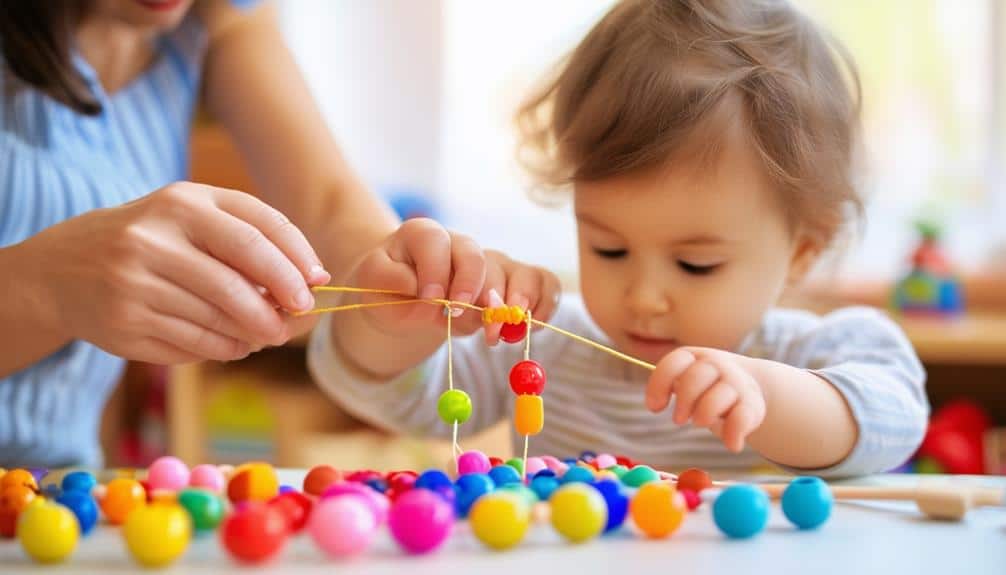
As children progress into kindergarten, the enhancement of fine motor skills takes on a more nuanced form, encompassing activities that require increased precision and coordination. These sophisticated Fine Motor Activities often involve tools such as pencils, scissors, and musical instruments, all offering opportunities for skill-building and enjoyment.
Here is a table illustrating some practical activities that can be incorporated in kindergarten to support fine motor skill development:
| Activity | Benefit | Tools Required |
|---|---|---|
| Writing letters and numbers | Enhances precision and coordination | Pencils or crayons |
| Cutting with scissors | Develops finger strength | Scissors |
| Playing musical instruments | Improves finger dexterity | Musical instrument |
| Using a computer or tablet | Supports skill development | Computer or tablet |
| Catching or throwing games | Improves hand-eye coordination | Various objects |
Incorporating these activities into daily routines can be beneficial, and occupational therapy can provide further support. Occupational therapists are skilled in creating tailored programs that help children master these skills at their own pace. Kindergarten children can significantly enhance their fine motor skills through consistent practice and patience, paving the way for future learning and development.
Benefits of Skill Development
Undeniably, developing fine motor skills in early childhood brings many benefits, ranging from enhanced hand-eye coordination to increased self-assurance. These skills are the building blocks that prepare children for more advanced tasks and are vital for everyday activities such as dressing, eating, and writing.
Fine motor development is not just about physical ability; it also provides mental and psychological benefits. It fosters independence, allowing children to accomplish tasks independently. This sense of self-sufficiency can significantly boost their self-confidence. Additionally, as children see progress in their abilities, they become more enthusiastic about learning and exploring, stimulating their intellectual growth.
Consider the following benefits of fine motor development:
- Improved academic performance: Enhanced hand-eye coordination aids in writing abilities, leading to enhanced academic performance.
- Preparation for advanced tasks: Children are better prepared for tasks like using a computer mouse or playing a musical instrument.
- Independence: Children gain confidence and the ability to accomplish tasks independently.
Therefore, providing opportunities that encourage fine motor skill development in early childhood is essential. This investment will significantly benefit the child’s overall growth and development.
Sticker Activities for Motor Skills
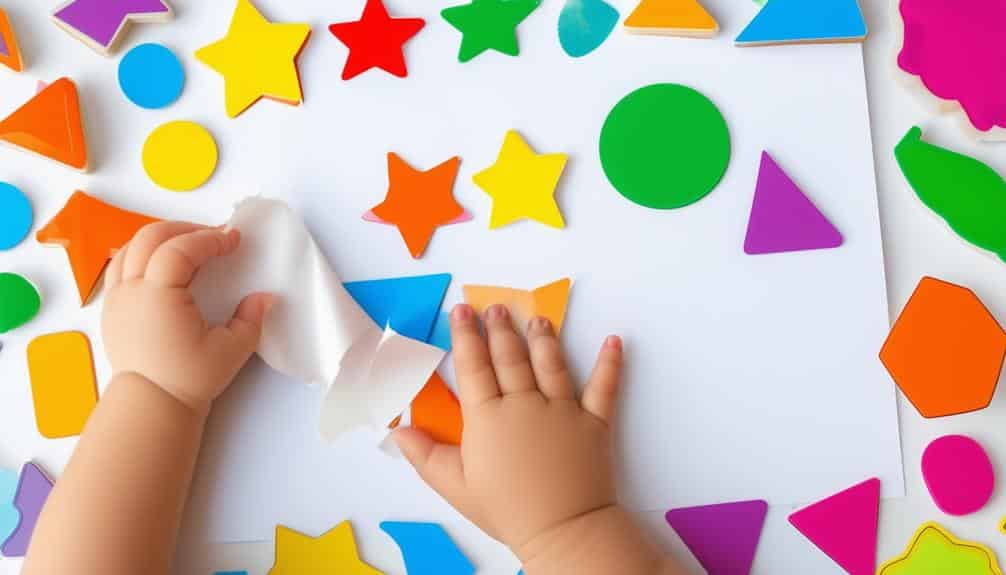
Incorporating sticker activities into a child’s routine is a practical and engaging method for fostering the growth of fine motor skills. This simple yet effective approach encourages children to use precise hand movements to peel and place stickers, enhancing their acceptable motor strength. Such activities are especially beneficial for preschoolers, as they promote the development of pincer grasp and hand-eye coordination.
Versatile and appealing, sticker activities can be adapted to various surfaces, allowing children to practice finger skills and control in diverse scenarios. This involves placing stickers on different surfaces and peeling them off from skin or clothing, further enhancing finger strength and coordination.
Sticker activities captivate children’s interest and provide a platform for them to learn, explore, and refine their motor skills in a fun and interactive way. They offer early childhood educators and parents a valuable opportunity to engage children in purposeful play while promoting physical development. Therefore, sticker activities are a beneficial investment in nurturing fine motor skills, contributing to a strong foundation for future learning and growth.
Stringing and Threading Exercises
Stringing and threading activities, such as bead threading, have numerous benefits, from improved dexterity to enhanced hand-eye coordination. A simple activity like stringing Cheerios not only aids in fine motor skill development but also fosters focus and precision. As children’s skills improve, they can be gradually introduced to smaller beads, providing an ongoing challenge that keeps them engaged and motivated.
Bead Threading Benefits
Many benefits are associated with bead threading, a simple yet powerful exercise that enhances crucial abilities in children, such as hand-eye coordination, finger dexterity, and grip strength. This activity is paramount in building fine motor skills necessary for daily tasks.
Bead threading is a mere game and an engaging activity that profoundly impacts the child’s development. It empowers them to foster essential skills while having fun. Its benefits include:
- Improvement of bilateral coordination as they use both hands to hold the string and thread beads
- Enhancement of problem-solving skills and creativity as they decide which bead to pick and how to arrange them
- Promotion of focus, patience, and concentration as they thread each bead carefully
Thus, bead threading is more than a mere pastime. It is a potent tool that aids in nurturing many skills. As a caretaker, parent, or educator desiring to serve children better, integrating bead threading into your routine can be a remarkable step towards enhancing their fine motor skills and overall growth.
Cheerios Stringing Activity
Offering a delightful twist to traditional bead threading, the Cheerios stringing activity provides an exciting yet effective way to enhance young motor skills and hand-eye coordination. This engaging activity promotes bilateral coordination as children use both hands to string the Cheerios, and it can be easily adapted for different skill levels by varying the size of the beads or the complexity of the patterns.
Encouraging children to thread Cheerios can help them enhance their concentration, focus, and patience while honing their fine motor skills. This fun exercise not only aids in developing their pincer grasp and finger dexterity but fosters a sense of accomplishment and confidence.
Below is a table showcasing the key benefits and materials needed for the Cheerios stringing activity.
| Benefits | Materials Required |
|---|---|
| Enhances hand-eye coordination | O-shaped cereal |
| Improves fine motor skills | String or pipe cleaner |
| Promotes focus and patience | Optional: Different-sized beads for varying skill levels |
Progressing to Smaller Beads
Progressing in developing fine motor skills, shifting to smaller beads in stringing and threading exercises presents an effective strategy that demands greater precision and agility from children. This progression challenges their hand-eye coordination and strengthens the small muscles in their hands and fingers, enhancing their fine motor abilities.
Using smaller beads for threading exercises involves:
- Enhanced focus and concentration as each bead must be carefully threaded
- Development of the pincer grasp, essential for writing and drawing tasks
- Building confidence through the mastery of a more intricate task
The increased precision required to handle smaller beads serves a dual purpose: it refines the motor skills necessary for intricate tasks and nurtures the child’s focus. As the child successfully threads each bead, the sense of achievement boosts their confidence, preparing them for more complex tasks. Remember, the goal is not speed but consistent progress. Patience, practice, and positive reinforcement are crucial. Progressing to smaller beads is a practical, engaging step in nurturing our children’s development.
Coin and Clothespin Activities
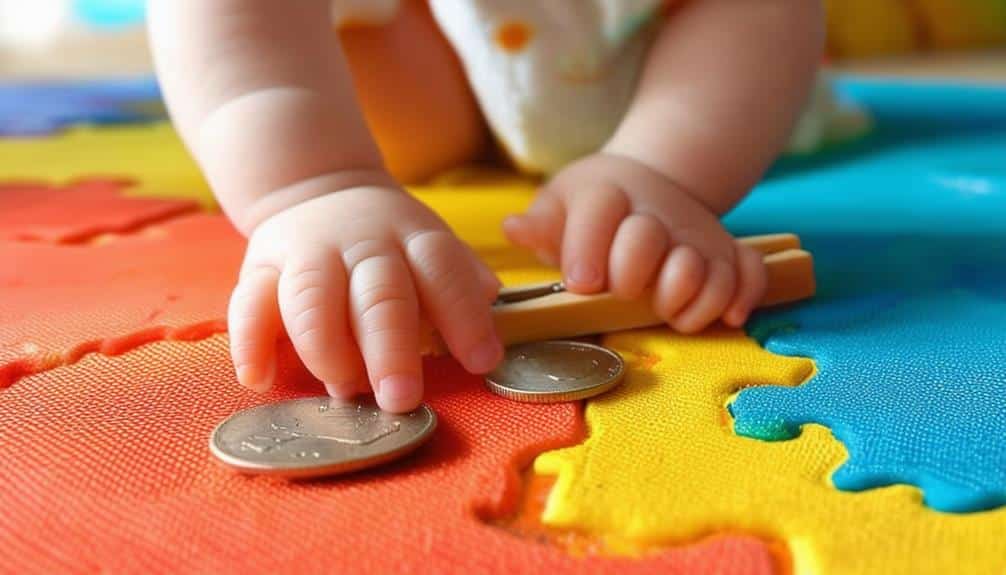
Coin and clothespin activities offer distinct, interactive opportunities to enhance a child’s fine child skills. Activities such as sorting and stacking coins strengthen hand-eye coordination and introduce basic maths concepts and organization. Similarly, creative exercise with clothespins can foster hand strength, precision grasp, and body awareness, which are vital for a child’s development and independence.
Coin Sorting and Stacking
Coin sorting and stacking activities, particularly those involving clothespins, can enhance a child’s delicate child’s skills by requiring precise, intricate hand movements and bolstering finger dexterity. This fun and engaging activity promotes muscle strength and hand coordination and prepares children for advanced delicate motor tasks.
Here are a few ways we can utilize coin sorting and stacking activities:
- Coin Sorting: Encourage children to sort coins by size, shape, or color. This activity demands high precision and attention to detail, strengthening the child’s fingechild’srity and pincer grasp.
- Coin Stacking: Instruct children to stack coins, one on the other. This activity improves hand-eye coordination and teaches children about balance and stability.
- Clothespin Challenge: Use clothespins to pick up and stack coins, adding an extra challenge. This can intensify the focus on fine motor skills, making the activity both demanding and fun.
Clothespin Creative Exercises
In early childhood development, clothespin creative exercises, specifically those incorporating coins, offer an engaging and practical approach to bolstering fine motor skills. These simple yet effective activities promote finger strength and coordination, which are essential for children’s independent performance of writing, eating, and buttoning clothes.
It is beneficial to use clothespins to pick up coins and place them in a piggy bank. It enhances pincer grasp, the ability to use the thumb and index finger to hold objects, and visual motor coordination, which involves coordinating visual input with physical movement.
Attaching clothespins to board books or clothing can greatly support independent dressing and give children a sense of achievement and independence.
Moreover, coin sorting and stacking with clothespins is an intelligent way to develop hand and finger strength. It improves fine motor skills and teaches sorting skills, an essential part of cognitive development.
Enhancing Body Awareness
Enhancing body awareness in young children through coin and clothespin activities can significantly bolster their understanding of their physical capabilities while fostering the development of fine motor skills. These engaging activities are practical exercises that strengthen hand and finger dexterity, which is essential for mastering fine motor skills.
- Coin activities like stacking and sorting coins allow children to gain hand strength and precision. Picking up a small metal disc, holding it, and placing it on top of another enhances their fin fingers’ awareness of the elements and capabilities.
- Clothespin activities, like attaching clothespins to a child or board books, can cultivate creativity while promoting fine motor skills. This activity demands hand strength and precise grasp, thereby improving body awareness.
- Using coins creatively, like placing them in a piggy bank, encourages pincer grasp and visual motor coordination.
Chalk Drawing and Lacing Activities
Exploring chalk drawing and lacing activities offers a delightful avenue for children to strengthen their hand power and hand-eye coordination while stimulating their creativity and imagination. These simple yet effective activities provide a fun, engaging, and custom-tailored environment for children to practice and refine their fine motor skills.
Chalk drawing can enhance hand and finger strength on sidewalks or driveways. As children grip the chalk, they exercise their finger muscles, which are essential for writing and buttoning clothes. Furthermore, the creative freedom chalk drawing provides can nurture their imagination and artistic expression.
On the other hand, lacing activities provide an excellent opportunity to improve hand-eye coordination. Using shoelaces, string, or specific lacing cards, children learn to manipulate and navigate through holes, fostering precision and concentration. These activities can quickly adapt to cater to various skill levels and age groups, ensuring continuous development.
Putty and Pick-Up Sticks Games
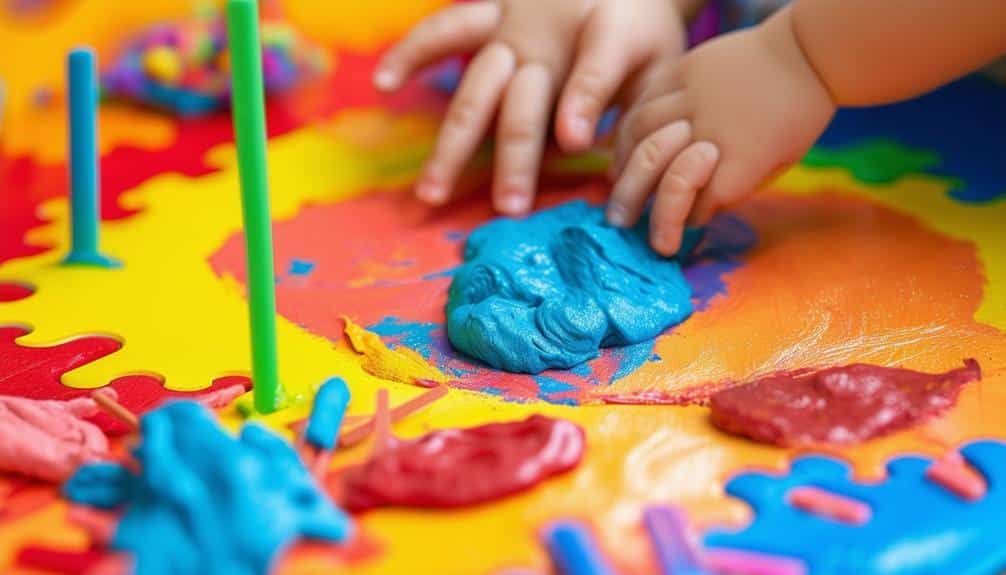
A plethora of benefits await children who engage in putty activities and the game of Pick Up Sticks, as these pursuits foster the development of essential fine motor skills. These games entertain children and help them refine their fine motor abilities and hand-eye coordination.
Putty activities are fun and engaging strength training exercises for little hands and fingers. As kids squeeze, pinch, and mold the putty, they unknowingly work on their hand strength and agility. The difficulty level can be easily adjusted, too. Begin with softer putty and gradually increase the firmness as their strength improves.
The game of Pick Up Sticks further encourages the development of fine motor skills and hand-eye coordination. This traditional game requires precision, concentration, and patience, as children aim to pick up sticks without moving others.
Using these activities, children can practice and enhance their:
- Strength and dexterity through the manipulation of putty
- Hand-eye coordination and concentration with the game of Pick Up Sticks
- Precision in small muscle movements is required for both activities
Bubble Blowing and Sorting Games
Turning our attention to bubble-blowing and sorting games, we find another set of enjoyable activities that can significantly contribute to a child’s development of fine motor skills. Bubble blowing, in particular, enhances oral motor skills while strengthening the lip and tongue muscles. Simultaneously, it encourages hand-eye coordination, a foundational aspect of fine motor skills.
Sorting games, on the other hand, enhance visual discrimination while demanding delicate hand movements. By categorizing objects based on specific criteria, children learn to process information while their fine motor skills are honed.
Let’Let’smine these activities in more detail:
| Activity | Benefits | Developmental Skills |
|---|---|---|
| Bubble Blowing | Improves oral motor skills | Hand-eye coordination |
| Strengthens lip and tongue muscles | ||
| Sorting Games | Enhances visual discrimination | Fine motor skills |
| Promotes problem-solving | Cognitive development |
Incorporating bubble-blowing and sorting games into playtime brings a multidimensional approach to learning, making it fun and engaging. Besides cultivating fine motor skills, these games stimulate sensory processing and foster cognitive development, proving their value in early childhood education.
Maze and Bead Activities
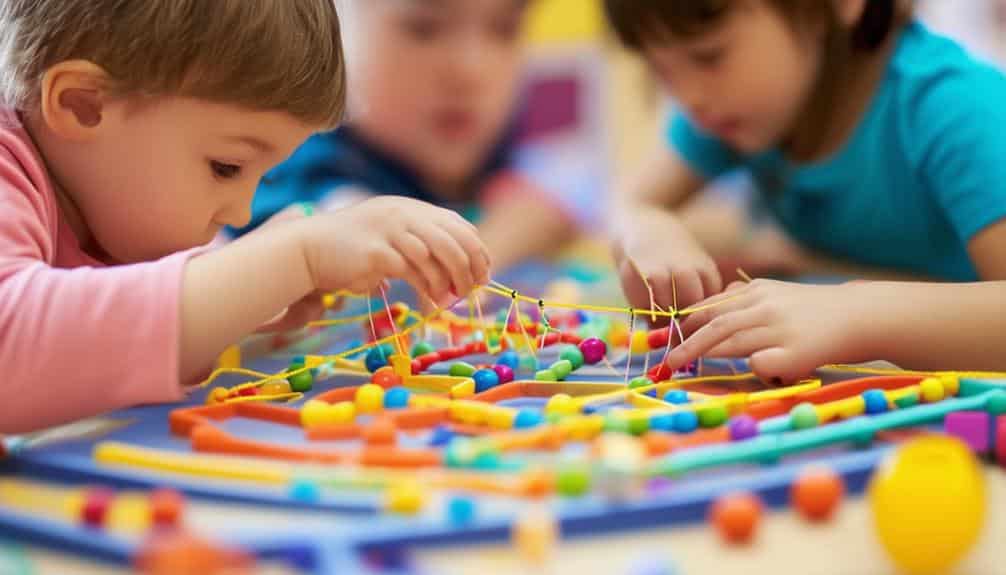
Delving into the realm of maze and bead activities, we find a rich source of opportunities for enhancing fine motor skills and cognitive development in early childhood. These simple yet powerful activities challenge and stimulate children’s physical and mental capacities.
Maze activities, for instance, are superb tools for boosting hand-eye coordination and nurturing problem-solving skills. A child exploring a maze must plan, execute, and adjust their movements, fostering spatial awareness and cognitive growth. Bead activities, on the other hand, primarily focus on improving fine motor skills and finger dexterity. Threading beads onto a string is a task that requires precision, patience, and bilateral coordination, thereby strengthening hand muscles.
To create an engaging environment for children, consider incorporating:
- Themed mazes that capture the chilchild’serest
- Bead activities with different textures and sizes to enrich sensory experiences
- Challenges that gradually increase in complexity to maintain engagement and promote growth
Maze and bead activities offer enjoyable and interactive ways to develop fine motor skills during early childhood. By integrating these activities into daily routines, we can help children explore their world with increasing confidence and capability.
Cutting, Gluing, and Tracing Exercises
As we progress in our discussion on early childhood fine motor skill development, we now focus on cutting, gluing, and tracing exercises. These activities are instrumental in enhancing children’s eye coordination, precision, and control and promoting creativity and self-confidence. The upcoming segments will focus on developing scissor skills, practical gluing techniques for kids, and how tracing exercises contribute to precision control.
Importance of Scissor Skills
Understanding the significance of scissor skills, such as cutting, gluing, and tracing exercises, is essential in early childhood. These activities can significantly enhance a child’s motor control, preparing them for more intricate tasks such as writing and drawing. Developing these skills contributes to the overall growth and learning of the child, equipping them with the necessary tools to engage effectively in their educational journey.
Scissor skills play a pivotal role in the following:
- We are strengthening hand muscles, which are essential for tasks requiring precision and strength.
- We are improving hand-eye coordination, enabling the child to perform tasks efficiently and effectively.
- We enhance spatial awareness and creativity, providing a foundation for problem-solving and artistic expression.
Moreover, these activities foster self-confidence in children as they learn to manipulate tools and create their masterpieces. It is vital that we, as caregivers and educators, provide ample opportunities for our children to practice these skills in a safe and supportive environment. By doing so, we aid their physical development and nurture their cognitive and creative abilities, setting them on a lifelong learning and discovery path.
Gluing Techniques for Kids
Building upon the importance of scissor skills, exploring the potential of gluing methods to enhance a child’s motor development is equally beneficial. Holding, squeezing, and guiding a glue bottle or stick requires a unique level of hand-eye coordination, precision, and control, which are fundamental to a child’s ability to build fine motor skills.
A simple activity such as assembling pieces of paper can notably promote spatial awareness. Simultaneously, it allows children to showcase creativity, nurturing their confidence and independence. Creating, learning from errors, adjusting, and observing a final product is a hands-on learning experience that is both enjoyable and educational.
Encourage your child to trace lines with glue to develop fine motor skills further. This will refine their grip strength and enhance finger control. However, remember to emphasize that the focus remains on the process, not the result.
Incorporating gluing methods into a child’s development is practical, cost-effective, and enjoyable. It enhances their abilities to manipulate small objects, a skill that will be valuable in their academic journey and beyond.
Tracing for Precision Control
While gluing activities foster spatial awareness, tracing exercises are equally instrumental in developing precision control and hand-eye coordination in young children. Tracing helps to solidify the connection between their eyes and hands, fostering an understanding of how their movements can create specific shapes or follow defined paths. This, in turn, strengthens their acceptable motor proficiency and prepares them for more complex tasks, such as writing.
To encourage tracing, consider the following practical strategies:
- Start Simple: Begin with basic shapes or lines before moving to more intricate figures.
- Use Various Materials: Different techniques, from sand to finger paint, textures can make the activity more er paint.
- Incorporate Daily Objects: Involve items like leaves or coins that can be traced to add a component of play and exploration.
Frequently Asked Questions
How to Develop Fine Motor Skills in Early Childhood?
Developing fine motor skills in early childhood involves engaging children in activities that enhance hand-eye coordination, finger dexterity, and hand strength, such as threading beads, buttoning, puzzles, arts and crafts, and games that involve catching or throwing.
How Can Teachers Help Children Develop Fine Motor Skills?
Teachers can aid children’s motor skills by incorporating activities like cutting, coloring, and tracing. Encouraging play with building blocks, puzzles, and self-care tasks can also strengthen hand muscles and coordination.
What three activities can you implement to support learners’ motor development?
Three activities to enhance learners’ motor development include threading beads onto twine, using safety scissors to cut out shapes, and building with blocks. These tasks promote hand-eye coordination and dexterity.
What strategies would you implement to help support fine motor skill development in infancy?
To support infantile motor skill development, provide textured toys for exploration, encourage object grasping, offer sensory play with materials like sand, and engage in strength-building activities like block stacking or puzzle solving.

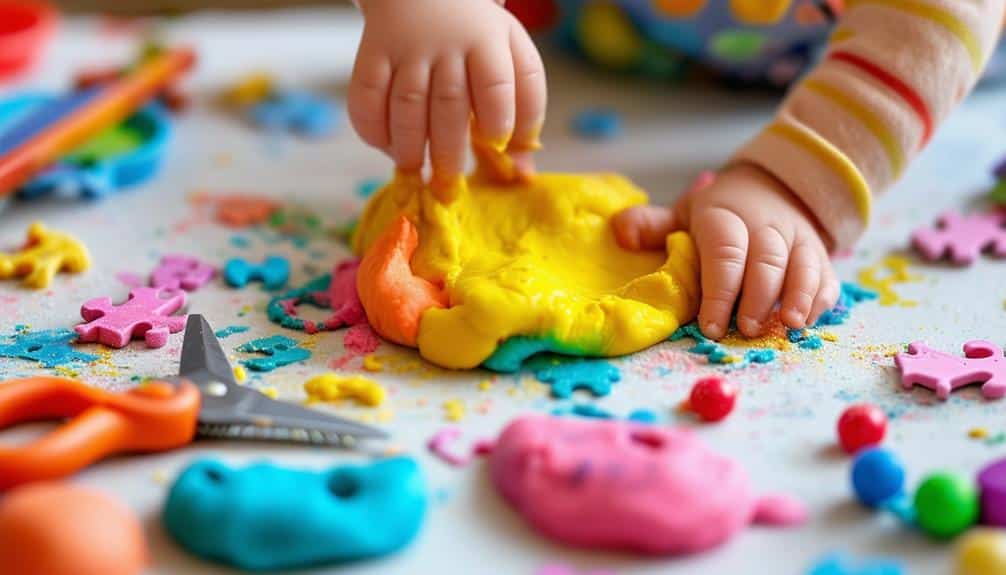
Recent Comments